
Garmin has just announced the availability of ECG (Electrocardiogram) functionality for the Garmin Fenix 7 Pro, Garmin Epix Pro, Garmin Tactix 7 AMOLED, Fenix 8, and Garmin Venu 3/3S units/series. These four different sets of watches all share the same new Garmin ELEVATE V5 optical heart rate sensor package, which is hardware-capable of ECG. The only previous Garmin watch to have ECG functionality was the Garmin Venu 2 Plus.
Garmin’s ECG feature will determine whether you have a normal sinus rhythm, or an AFib condition. It does this on-demand (when you request it), versus a 24×7 background process like some other smartwatches (looking for irregular heartbeats, which in turn can suggest an Afib condition). Upon the conclusion of the 30-second test, it’ll give you the result as well as let you export the full report as a PDF to give to a doctor. This feature does not detect heart attacks.
The functionality remains the same as the Venu 2 Plus, but given that Garmin changed the optical HR sensor package, they had to redo/re-fill portions of their FDA certification related to the ECG feature. Remember that Garmin, like Apple/Samsung/Fitbit/Google/etc, have all gone through the formal FDA certification process, which classifies the ECG app as a medical device. This includes doing a full study of 600+ participants and everything else that comes with proper medical device certification (I’ve outlined how that worked previously, here).
Setup & Usage:
With that backstory, let’s quickly walk through how to set it up on your device. Here’s what you’ll need (aside from checking the country/device compatibility list):
A) To be physically in one of the approved countries (all models for the US, but selected models for the EU and other specific Asian countries).
B) Have one of the compatible watches noted above
C) Have updated your Garmin watch firmware
D) Have updated your Garmin Connect Mobile smartphone app firmware
Practically speaking, if you’ve got an even halfway-recent Garmin watch/app firmware, it’ll work. Garmin had effectively locked the functionality down until this morning, but it was already in the units until FDA approval had been completed. Likewise, for the location piece, as with the Garmin Venu 2 Plus, Garmin has not yet received approval in the EU/CE, or other regulatory bodies. Thus the requirement that you be physically in the United States or another approved country, for your first activation.
Once you’ve activated the ECG functionality on the watch once, you can use it anywhere in the world (as evidenced by me activating it in New York City a few weeks ago, and then flying back home to Amsterdam and using it there without issue). Note, that at some point as part of this process, it turns on (permanently) and requires two-factor authentication (via e-mail) on your Garmin Connect account. This can impact a handful of 3rd party apps like RunGap that don’t leverage the official Garmin API’s (it doesn’t impact apps like Strava/Zwift/TrainingPeaks/Komoot/etc…). Given my account has been enabled for two-factor authentication for years, this isn’t something that’s impacted me (or even asked of me in this setup process).
To get started, you’ll open up the Garmin Connect app, and then go into your device settings, where you’ll see the option to ‘Finish Setup’. Essentially, this is now enumerating a new option for ECG setup:
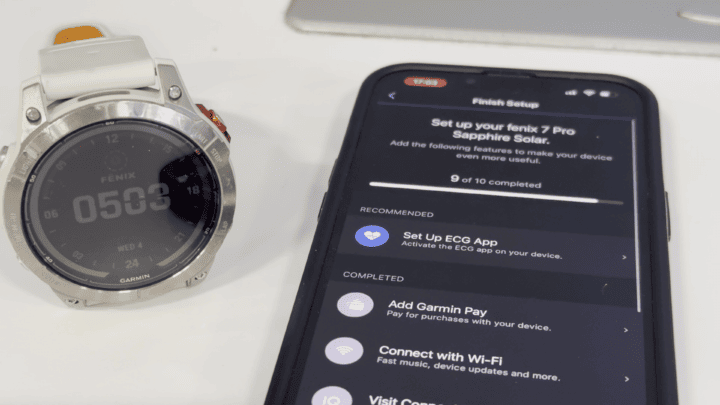
From there you’ll confirm your birthday, as it’s required to be 22 years or older for the ECG functionality.
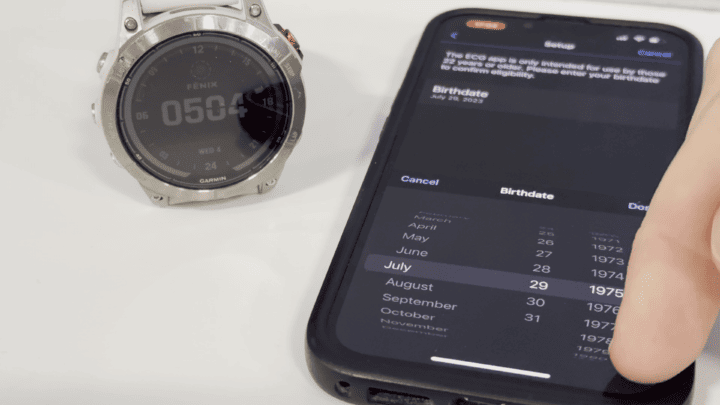
After which, you’ll be given a few pages of information on what the ECG functionality does:
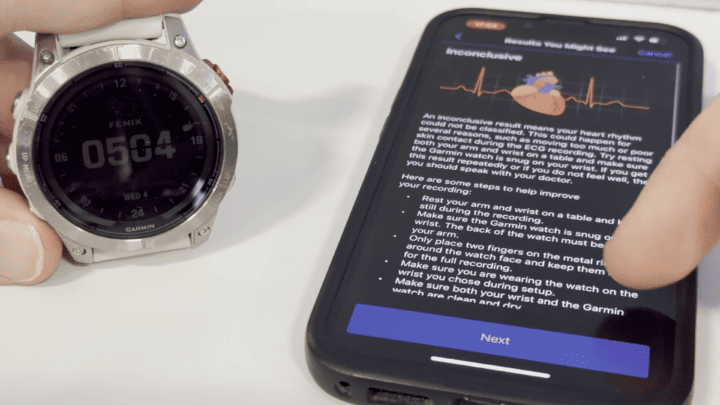
Upon the conclusion of your brief learning session, you’ll do your first ECG trace. To do so, you’ll put your opposite two fingers on the bezel of the watch, which completes the circuit in order to measure correctly:
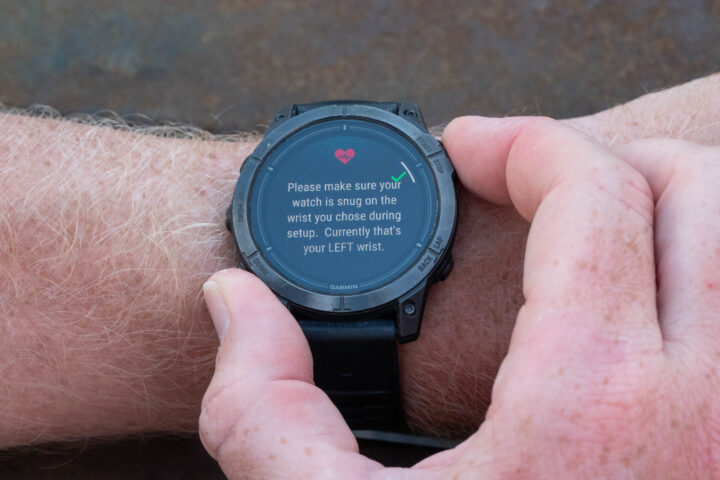
The process takes 30 seconds. If you move too much, it’ll fail out. Likewise, if you remove your fingers, do the YMCA song dance, or anything else, it’ll tell you to try again. It will again remind you that this does not detect heart attacks:
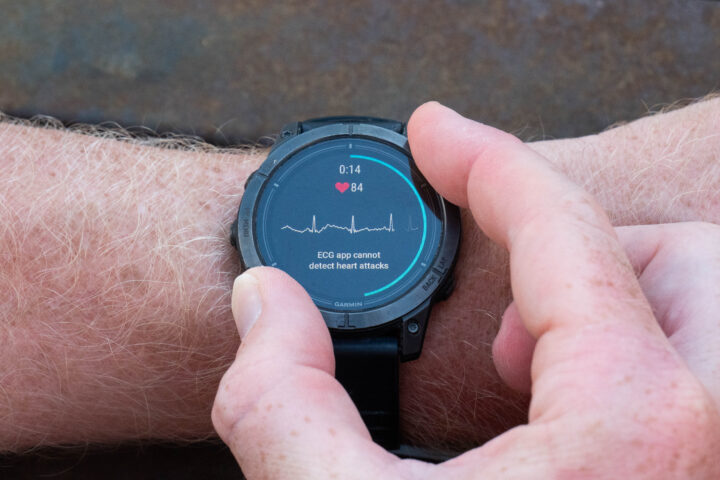
Once you’ve finished, it’ll give you the results:
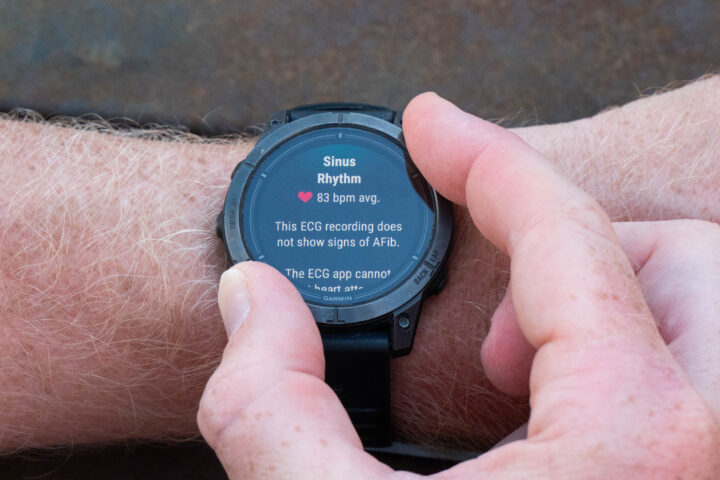
As you scroll down, it’ll again remind you that it does not detect a heart attack:
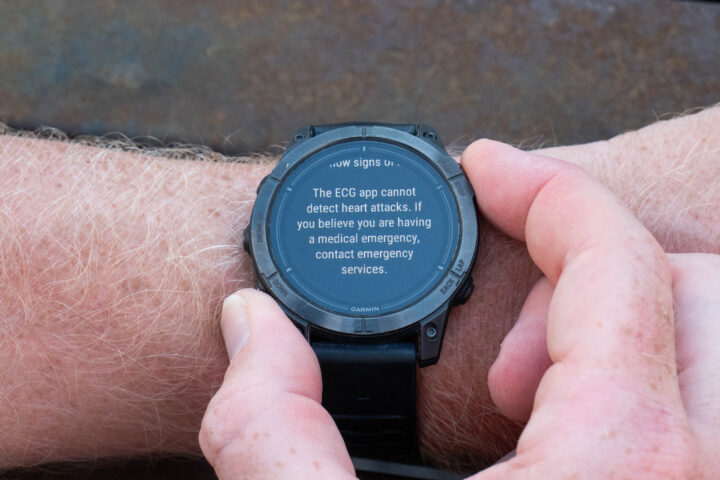
Additionally, you can log symptoms:
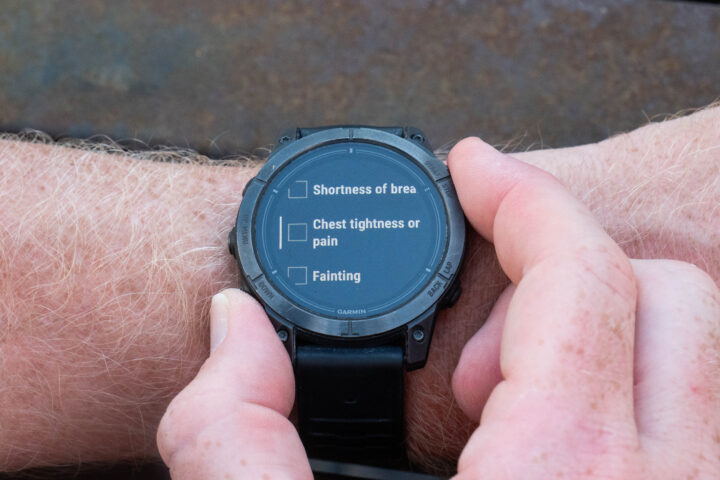
These are then saved alongside the data in your Garmin Connect account, and also shown on the ECG data export/PDF file:
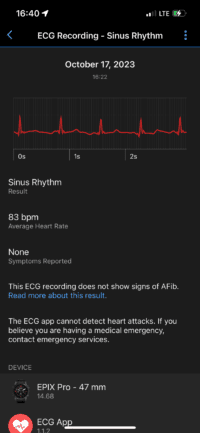
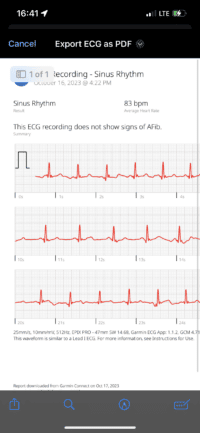
Upon the conclusion of your first ECG trace, the unit/app will note that you’ve now activated the ECG app on your watch. From here on out, you’ll find the ECG app in the same general area as other sports apps (except on the Venu 3, where it’s under the separate app section for non-sports apps). In my case, I moved it to the top of the list as a favorites, otherwise you’ll scroll down a bunch:
Additionally, after completing this first ECG trace, you’ll now be able to do an ECG anywhere on the planet without restriction. This is because the FDA views this roughly akin to taking medicines while you travel, essentially considered self-care.
Again, all of this is exactly as it was on the Garmin Venu 2 Plus when it launched ECG functionality back this past January 2023.
Going Forward:
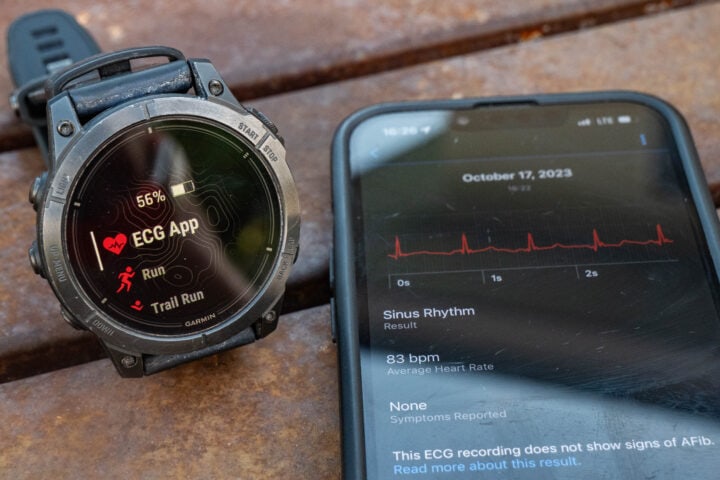
At this point, Garmin is positioned that virtually all watches with the Garmin ELEVATE V5 optical HR sensor (the one found in the Fenix 7 Pro, Epix Pro, Tactix 7 AMOLED, and Venu 3/3S), will likely have ECG enabled. Yet, there remains the chance that Garmin could continue to launch some lower-end models with the older Garmin ELEVATE V4 sensor (and lack of corresponding connecting lead needed for ECG). For example, Garmin recently launched the Garmin Vivoactive 5 watch with the ELEVATE V4 sensor. That watch does not have the required hardware to make this work.
In that case, that watch was essentially a cut-down version of the Garmin Venu 3 (which does have the required hardware). Of course, Garmin does have to keep in mind that Fitbit has ECG functionality on their Fitbit Charge 6 (and previous Charge 5) at the $159 price-point. Certainly, there’s debate one can have about the differences in feature-sets between a Fitbit Charge 5/6 and a Garmin Vivoactive 5, but the simple fact remains that a unit half the cost has the feature the more expensive Garmin watch doesn’t.
In any case, I’m sure over time things will equalize and it’ll become ‘just another feature’ that’s on the watch/enabled in the same way it is for other watches and/or brands.
With that – thanks for reading!
Found This Post Useful? Support The Site!
At the end of the day, I’m an athlete just like you looking for the most detail possible on a new purchase. These posts generally take a lot of time to put together, so if you're shopping for the Garmin Venu 3, Garmin Fenix 7 Pro Series or Garmin Epix Pro Series or any other accessory items, please consider using the affiliate links below! As an Amazon Associate I earn from qualifying purchases. It doesn’t cost you anything extra, but your purchases help support this website a lot.
And of course – you can always sign-up to be a DCR Supporter! That gets you an ad-free DCR, access to the DCR Shed Talkin' video series packed with behind the scenes tidbits...and it also makes you awesome. And being awesome is what it’s all about!

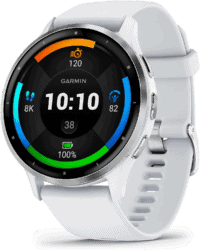
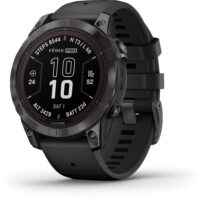
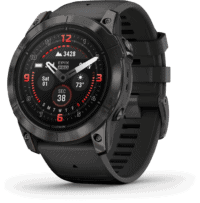
















Thanks Ray
In previous posts re ECG watch functionality, I’ve seen a number of comments questioning the need and logic for adding this to Smart Watches.
From personal experience, I can say that if you develop an arrhythmia, the ability to show a cardiologist an ECG rather than simply describing a sensation is invaluable. It doesn’t need to be a 12 lead hospital grade ECG to be very very useful.
I hope Garmin add this to their full suite of watches down the line.
I was alerted by an Apple Watch that I went into AFIB (no cardiac history in family or myself…suspect was recent bout of the COVID or possibly RSV). I have had three Cardiologists tell me that the ECG capability in a smartwatch is the best tool to have for a consumer to detect AFIB. Upgrading to the ULTRA was the easiest discussion with my wife over high dollar expenditures…ever. Luckily, since being electrocuted, well shocked/jumped started back to normal, I have had no issues but regularly check.
You are correct. As an ER doctor and running/cycling enthusiast, when I see a patient with syncope (passing out), a brief episode of resolved palpitations, or even chest pain/shortness of breath, the first thing I look at besides their overall condition is their watch. While a one lead EKG may seem limited, and it is in some regard (True it can’t detect a heart attack, 12 lead required), it is much more useful then people realize. There is a difference between what the algorithm is FDA approved to detect, and what a trained eye can interpret from the raw tracing. I have diagnosed SVT, a.fib, Prolonged QT, Peaked T waves suggestive of hyperkalemia, Bundle branch blocks, 3rd degree heart block etc.
The reason this is valuable is many arrhythmias like a.fib and svt are what we call paroxysmal, meaning they come and go. If someone has a tracing at the time of their event, and I see SVT, but symptoms are resolved, my 12 lead is unlikely to confirm the diagnosis and I will refer to cardiology on the correct assumption of the one lead trace the patient gave to me.
If someone feels lightheaded, takes a tracing, passes out, comes to ER. 12 lead may or may not be normal if arrhythmia has resolved. But risk of it returning could be high and it can be missed in a 2 hour stay. But if I see their HR dropped below 40 or above 150 (with context of symptoms/non athlete etc), and see a tracing, I can make important conclusions about a medical condition that neither I nor a cardiologist would be able to conclusively diagnose if we didn’t have the point of care information when symptoms were present.
Unfortunately these devices do not differentiate between Afib and PVC’s Thousands of dollars later in tests, Dr appts and ER visit I am fine. I don’t wear the Apple watch anymore for this reason.
I don’t understand Donna, why wouldn’t you simply disable the feature on the Apple Watch? It’s unclear to me why you’d have to takeoff the watch forever. It’s literally a single toggle. Likewise, you have to go out of your way to enable this on the Garmin watch, and then further, manually do an ECG trace.
My Apple Watch has never classified PVCs or PACs as Afib. If I have more than 8ish in a 30 second sample it says ‘inconclusive’. Everything else it classifies as sinus rhythm which I suppose is correct.
The area I find these watches lacking is identifying atrial flutter.
I was mad at Apple for not putting out a more descriptive warning. And all the tests cost me too much money. I was wearing 2 watches anyways…my Garmin and Apple. Now I just wear my Garmin. Simply put I was being the little kid who stomps their foot and says “I don’t like you anymore” LOL
As someone that has frequent PAC and PVC, would this be a good thing for me to have do you think? I’ve worn about 5 24hr HR monitors and only detected symptoms once. Then this week I’ve had palpitations every day. When i saw this news, I became excited, but don’t want to blow the money if it’s worthless.
Do you think this would be a good purchase for me?
@Alex, there are a few devices you should consider.
These watches (Garmin/Apple/Fitbit etc.) are useful as they are on you 24/7 so you can very quickly record an ECG as soon as you feel a sensation. Problem is they are pricey and generally only do a 30 second reading.
Kardia Mobile do a stand-alone and very small ECG device which links to your phone via Bluetooth. They do a single lead and six lead version and can record up to 5 mins. It’s a great device and is surprisingly cheap but won’t necessarily be with you 24/7. As with a watch, this would be a reactive device on feeling a sensation.
Fourth Frontier do an ECG chest strap that can be worn 24/7 and can record for a full 24 hours like a holter monitor. It’s a bit pricey and requires commitment to wear regularly but it’s proactive in that if you feel a sensation, you don’t have to start an ECG and hope it happens again. It’s recorded.
The correct device for you would depend on whether you think you can secure an ECG trace that shows symptoms for which you are concerned.
I think most people would think I’m over the top and borderline obsessive on this, but I had AFib until it was corrected by an ablation. I now rarely have symptoms beyond the normal PACs and PVCs, but when I do have a wobble, it’s very useful to be able to show my cardiologist the ECG from my Fourth Frontier.
Totally agree with the benefit of having ECG on a watch to capture paroxysmal arrhythmias. As a paramedic I’ve found this valuable at times when looking at the trace captured by a persons watch. It’s frustrating that all the watch makers won’t do what Polar has decided to do with the Vantagr V3, and just have the ECG sensor active without worrying about medical certification of arrhythmia detection algorithms. At least more people worldwide could capture arrhythmias to show a trained medical professional in these circumstances. It’s not like they can’t perfect and eventually get FDA clearance for arrhythmia detection later on.
Doc, or another med professional…
Can you comment on whether you think having continous monitoring is important, or conversely, is it not worthwhile to only have it on demand.
I have been all android and garmin for so many years, needed to upgrade things and have original venu so was looking at getting venu 3 for BF as it would have ECG. Have been pushed by every other person I know to move to apple so they can see the dots when I text; I was thinking of moving for the watch so I could get ECG. Love that my Venu goes 3 days, was excited the Venu 3 goes 5 days, but if ECG only on demand is not worth it, time to move. Otherwise, easy for me to get a Venu 3 and new Samsung/Pixel. TY
ECG on the Apple Watch is only on demand.
True about ECG, but they scan the data from the PPG for patterns that might indicate the presence of Afib. This is helpful for people who are non-symptomatic.
Picture 4 and 5 are the same picture :-)
looks like it don’t work with VPN to US?
1) update your watch and Garmin Connect App to the last version.
2)On your phone, install “Fake GPS Location” and set it to somewhere in the USA (NewYork). Don’t forget to enable the app in the dev options of Android under “Select Mock Location App”.
3)Set your location in your Garmin Account (Garmin.com via the website, not Garmin connect profile) to USA.
4)Configure your watch on Garmin connect and use the ECG for the first time
5)Reset everything (gps, account) to your default
Enjoy ECG app outside US…
Probably GPS location related.
what does it mean to set location in Garmin Account? Entering text in Profile setting?
Which version of Android GC do I need?
I struggled around and found this tips on other side, but looks like Garmin Account himself can’t be changed back, so I am a US User :-;
Doesn’t work for me
I am connected via VPN to US and fake GPS position. Still the ‘ECG setup’ does not show up.
Any ideas?
Set your account on Garmin.com to us and English language
Found the solution: I had to change my location to US in my Garmin Connect profile
—
Doesn’t work for me
I am connected via VPN to US and fake GPS position. Still the ‘ECG setup’ does not show up.
Any ideas?
Log out, close the browser, log back in and then you can change it.
Can you please write down a step by step guide?
Just log out of your account and log back in then you can change the country again.
Do you know any resources for determining what sensor a watch has? Have a brand new instinct 2x but don’t know if it is elevate 5 …
Only the watches listed above have V5, everything else is V4 or earlier.
Thank you.
Thank you for this guide. I’m in Japan. Worked perfectly.
Hi,
I did all steps. Have a fake GPS instaled and running (I can see my location in Google Maps in US),
have latest version of Garmin Connect, In my account setup I have typed location United States, language set to English and still don’t have this option in Garmin Connect to Finish Setup…
What else should I try?
Thanks! It was about setting location at the Garmin account I didn’t know! Now it works like a charm 😁
Do you know if they plan to have it run as a background process as well down the road?
How could they? Your finger touching the bezel is one of the “electrodes” used for the measurement. You have to hold there steadily for some 30 seconds
“Garmin’s ECG feature will determine whether you have a normal sinus rhythm, or an Afib condition. It does this on-demand (when you request it), versus a 24×7 background process like some other smartwatches.”
The 24/7 monitoring on other smart watches doesn’t detect Afib, and it can’t. What it can detect is an irregular pulse through the optical sensors and alert you to the possibility of it being Afib, at this stage you could do the ECG to capture the electrical rhythm to actually determine Afib. It’s impossible for a watch to do 24/7 ECG monitoring because of the way ECG leads work, as you need two points on opposite sides of the heart to read the electrical activity. This is impossible unless you’re touching the watch which makes your left wrist one point and your right hand the other (your left and right arm are on opposite side of the heart)
They could add a jack for an extra electrode wire you could run through your sleeves to a bracelet on the other wrist.
I truly hope they add passive scanning for Afib similar to Apple, Google, and Fitbit.
>>>>but the simple fact remains that a unit half the cost has the feature the more expensive Garmin watch doesn’t<<<.
add the forerunner 955 etc to the list. very disappointing
Does this detect other arrhythmias such as PVCs and PACs? Those are far more common than AFib.
On the Apple watch my PVC’s show up as AFib. Cost me thousands of dollars in Dr appts and ER visit. I don’t wear my Apple watch anymore because of this and do not want this feature on my Garmin.
Are you saying you DON’T want it to detect your PCVs and PACs? and are you saying thousands of dollars for nothing? I have frequent PACs and PVCs. It drives me nuts, but Dr pretty much says it’s nothing to worry about.
Does this include the Enduro 2?
Waiter walks up….looks across the dining area….”I’ll have what they’re having!”
Thanks, Ray!
– Can it detect other abnormalities besides atrial fibrillation?
– Ok the possibility of adding continuous monitoring for irregularities: given I imagine that type of monitoring doesn’t use the EKG functionality (which requires two fingers on the bezel) and just uses the HR sensor as-is, that would have already been done if possible and if Garmin wanted to or does that functionality itself require a separate FDA approval?
Hi all,
IMPORTANT information: once having ECG activated, the 2FA is madatory. Meaning, everytime you login (web, app etc.), you receive a security code (mail, text message) and can only enter your account with that. You cannot deactivate the 2FA (seems to be a requirement for FDA certification).
So far so good. Or not so good, since no 3rd party App (in my case: RunGap and SmartscaleSync) can access Garmin Connect anymore. Haven’t found a solution yet.
@Ray any ideas on that?
Is 2FA only required when needing to log in or every time I open the Garmin Connect Mobile app?
Most probably only when you login the first time
Not sure, I’ve had two-factor auth on my account for at least a year or two now, so not something I even think about anymore.
Admittedly, I don’t use Rungap much, so not something I run into. But all other 3rd party apps that authenticate properly work just fine.
HealthFit on iPhone can pull GC data from Apple Health if you’re syncing that way. So Apple Health pulls in GC data and HealthFit then pulls *that* data, giving you an exportable .fit file. Not sure if that fits your needs, but might be worth looking at?
I think most people use RunGap to pull data from Garmin and then push it to Apple Health. So Healthfit would not work.
darn I didn’t think of this and just broke my workflow :(
@John, there’s some data fields that GC doesn’t write to AH that Run Gap picks up – which made for better data in Healthfit.
Gonna have to try another route now. GC to Strava to AH maybe?
Thanks John. My principal problem will be smartscalesync that writes body data to GC. Rungap does nit work anymore but I can find a million workarounds (e.g. import from Strava) for that,
In any case, fyi for those in my situation
Ray, thanks. Would be perfect if Garmin offered a proper API. The problem ocurs when 3rd party apps need to circumvent the API to offer additional sync (like in my case smartscalesync)
I am having the same issue on two way authentication. Run Gap no longer works for Garmin. If anyone knows how to turn this off please let me know. I’ve deleted the EKG app from Garmin connect but it is still requiring 2 way FA.
“Would be perfect if Garmin offered a proper API.”
There’s no topic that Garmin and I spare on more sharply than this. Years and years of me debating it with them, sometimes privately, sometimes publically.
The funny part is, they do actually offer such a proper API – it’s what Zwift, TrainerRoad, and like two other apps use. They got in early, then Garmin basically closed the door. It was mostly designed for indoor training apps where Garmin at the time didn’t have a competitor. Then the Tacx Training App came along as part of the acquisition.
That said, I don’t really understand the 2FA requirement here from Garmin, since I’m reasonably sure my Fitbit account doesn’t have it on, yet has ECG enabled just fine. Apple is a bit wonkier, since I suppose they could argue the phone itself (the only place the data is visible) is effectively the second factor. Meanwhile, Samsung is the same and has 2FA enabled/required for Samsung Health.
Let me know when you find a work around. Super annoying. I deleted EKG app and it’s requiring 2 FA
Seems there is no workaround, and – worse – no way back. Would love to deactivate the ECG, but…. no.
Maybe you can inform Garmin as well: link to forums.garmin.com
The garth project may address these authentication issues. It has recently been added as the backend for garminconnect (the open source python project). There is an example of using it to upload scale measurements. It may be adaptable to smartscalesync.
Hi Ray,
thanks for your API info.
I’d quote you: “I don’t care how a company gets accurate results, as long as they do.” You mention that in the GPS-accuracy context. I would like to say: “I don’t care how a company gets their API running, as long as they do”. Garmin does not, and I am REALLY pissed.
The problem here is that Garmin sees it as a business issue, not a technical one.
Simply put, they don’t want 3rd party companies leveraging their garden as a free-for-all playground. In effect, that’s what RunGap is doing. It’s indirectly allowing a company without a web platform (e.g. Wahoo) to utilize Garmin Connect instead.
Remember, with RunGap, it’s not using the API for injecting activities into Garmin Connect. It’s using your saved credentials and pretending to be you. Most security folks find that sketchy, Garmin included. Now – do I worry about it with RunGap specifically? No, of course not. They do cool stuff. But practically speaking, that’s why it doesn’t work.
If RunGap were leveraging the standard push API (from Garmin Connect to RunGap), there would be no problems at all. Of course, they aren’t because they’re doing the opposite (into Garmin Connect), for which they aren’t allowed/can’t get access because of Garmin business policies.
Thanks again, it’s getting off topic.
I perfectly understand the issue, from busines as well as technical perspective. As a Garmin sustomer, I pay for the products with Dollar and Data.
Lastly, I am not so much cocerned with RunGap (that I also use) but much more with smartscalesync. In other words, Garmin excludes me from importing my data and (wants to) force(s) me to buy their scale.
Simply put: I am not the owner of my data.
Garmin isn’t preventing you from importing your data. On both the web site and the phone app there’s a place where you can manually enter your weight. I have a Withings scale and use smartscalesync, and if smartscalesync suddenly stopped working that’s what I’d do. (Actually I probably wouldn’t even bother. I have no real need for my weight on GC.) Annoying, not the end of the world and they’re not forcing you to buy their scale.
What Garmin should have done is very explicitly warned about 2FA. Now they should provide a way to turn it off. If they also want to turn off recording ECG from your watch when you ask to turn off 2FA, that’s fair.
Paul, thank you for your point of view, which I do nor share
so far the only time its asked was during setup- Connect hasn’t asked again for the moblie app, the web site or logging into my account online (where you can edit location details and such).
This completely messed up my backup workflow, which is to use a Python script to download the activities, link to github.com
Sad it can’t be turned off, because I don’t want ECG.
ECG heaven for 30 seconds and a very poor heart rate optical sensor for 24/7…
No HRV measuring with that? Was hoping I could take off the watch while sleeping an do the HRV-tracking via ECG-measure in the morning… (I know the snapshot function but HRV over oHR is too faulty)
Do you know if the Epix 2, Fenix 7 non pro versions will get an ECG too?
Or if the Elevate v4 version basically
I didn’t see the Epix 2 Pro was coming 😤
No, those lack the internal hardware (primarily the lead and isolation ring).
I feel like I have to spend my Scandinavian Airlines Eurobonus points now… Norway to USA, day trip be like!
Set it up just fine on my Venu 3 and did a couple readings, no problem. Set it up as a “swipe right” shortcut, but when I swipe right, nothing happens. All the other apps etc work fine when set up as swipe right. Not sure if this is a bug or intentional…
Any indication when the ECG feature will become available in UK/EU? It is a long way to theStates to start the App.
Works fine when you follow Oliv’s description in #8
Has anyone had any trouble getting this to work? I’m in the US, and I get as far as attempting to take the first reading. It never gets to the acquiring signal screen. I’ve restarted the device, my phone, killed the app running in the background then restarted the phone and the watch and then Connect, shaved my wrist, and worked with Garmin support to no solution.
Now just need to keep waiting for the sleep coach functionality to be added as well :) any word on that from garmin that you’re aware? :)
Thanks for another nice article
Anyone who got a guideline for IPhone 📱?
Same procedure basically, but you’ll need a PC or Mac on which you can install a GPS location changer. Worked like a charm for me.
Hi there,
Greetings from Portugal 🇵🇹
I am your follower since the beginning, nice work, you are great!
Greats news and bad news….
physically in the United States? 🫣😱
Europe? When do we expect such waited feature?
Thanks
Seems like there is a work around if you look at post #8.
how did you enable this? It seams that it is only 3 countries including US that has been enabled for this
“From there you’ll confirm your birthday, as it’s required to be 22 years or older for the ECG functionality.”
I’ve never heard of 22 being a minimum age before. Do you know if this is actually required by the FDA or is something ‘required’ by Garmin. I’m very skeptical of places that REQUIRE a birthdate but it’s really only for their marketing, like to enter the lottery for MLB playoff tickets. ::rolleyes::
It’s an FDA requirement. You’ll see the same language on every ECG medical-certified device that’s detecting Afib, both smartwatch and non-smartwatch alike.
Instructions for activating this using an iOS device.
As there is no working solution using an app on iOS, I found this, and it worked for me.
1. Change account location to one of the three locations Garmin has approval to use (US, Hong Kong and Vietnam)
2. Use VPN
3. Using a PC or Mac, iMyFone AnyTo app. Install and follow the instructions, Basically, you’ll be prompted to connect your device by usb, adjust your settings to develop mode on your iOS device, and then restart. Once you have the iMyFone AnyTo app opened and ready to use, select (as instructed) a location, I typed in Central Park, New York (making sure your selection marries up with what you chose as your Garmin account location above) and then hit teleport.
4. Open up Garmin Connect on your device, and then follow DC Rainmakers instruction.
Once you have set it up, done an ECG, close the app. Go back into settings/privacy/ and turn of developer mode. Disconnect device, restart device, and it will have reset to your current location. Use maps, or any other app that shows your location to confirm, and don’t forget to change your location in garmin.com back, and turn off vpn.
I then went back to check that the ECG app works, by using my watch.
I do not quite understand all this fuss about an “ECG” (very limited) functionality that brings very little in the end. I could understand if there was a constant monitoring of possible afib (like the Apple watch I believe) but any $40 blood pressure monitor detects afib. I no longer use my galaxy watch 3 ECG, it is in the end much easier to use a blood pressure monitor to detect afib plus you get your… blood pressure as an additional benefit.
Does Garmin have a heart rate range in which the ECG app works? Can you stop mid-workout with a heart rate of 190 and use it? Apple’s max is 150, but I can’t find any documentation on the bpm range for Garmin.
It also seems like Garmin could introduce a HRM that ran the current for the ECG from the HRM to the watch, couldn’t they?
I watched the DCRainmaker explanation video of ECG on the Epix Pro in slow motion and noticed that Garmin’s setup text in the app says this:
If your heart rate is over 120 beats per minute (bpm) or under 50 bpm, the ECG app cannot check for AFib heart rhythms. In these cases, the result will be inconclusive, and your heart rhythm will not be classified. If you get this result repeatedly or you do not feel well, then you should speak with your doctor.
A heart rate below 50 bpm can be caused by taking some medications or by certain heart conditions.
[quote]
Some people with high fitness levels may also have a heart rate below 50 bpm.
A heart rate above 120 bpm is common while exercising and for a short time afterward. It can a be caused by high stress levels, an infection, dehydration, alcohol use and certain heart conditions, including
[/quote]
So it looks like in this respect at least, Garmin lags behind Apple in terms of the maximum heart rate for which they’ll certify the feature.
Thank you to TJ for this workaround, worked perfectly, but Is there any way to turn off the two-step verification afterward?
Hello
My partner has a visual impairment. He has recently purchased a Polar H10 heart rate monitor but would like to pair it with an app, watch or device that has speech or audio alarm that will alert him when he reaches his maximum heart beat per minute which he can customise to the zones as advised by his heart clinicians, without the need to reset each time he exercises.
Looking at various web communities, this is a feature that would be appreciated by many.
Could anyone suggest a way of achieving this please.
Many thanks
So… if I’m really fit and my resting HR is around 35bpm these days it’s useless to me unless I am actually experiencing aFib, which might put me in the usable range. Hmm, not sure how I feel about that.
I had set up the ECG app on my Venu 3 and took an ECG in Novemeber after reading this. Now I can’t find the ECG app in Apps on the watch even though Finish Setup shows I set it up. Anyone having this problem?
I’m on the 8.25 sw version
thanks!.
There are watches that measure blood pressure via their ecg or other functionality (monthly calibration required). Do you think Garmin will implement this too?
Can the ecg be triggered from the smartphone or only at the watch?
Do they do it accurately? It’s not worth it if they don’t. I have high blood pressure and would like to see it, but not if it’s not accurate. That none of the major watch brands offers blood pressure or blood sugar tells you something about whether it’s possible to do accurately.
My resting heart rate is well below 50 bpm. The ECG app complains with “heart rate too low”.
In your video the HR is in the 80s, what did you do to get the HR that high? Is it still a valid read if you artificially elevated the HR just for the ECG?
“versus a 24×7 background process like some other smartwatches (looking for irregular heartbeats, which in turn can suggest an Afib condition)”
Ray,
Any chance Garmin will enable the background process as found in the Apple watch or Fitbit anytime soon? According to material I can get my hands on they have the ability to do this.
Hello. It seems I lost this functionality with 16.22 upgrade on my Epix Gen2 Pro. Any ideas how to restore? Thanks. Franck
I do not understand why ecg certification for Europe takes so long. Others manufacturers offer ecg functionality for many years.
Hi Ray. Question. I have epic pro gen 2. I am in US now but can’t trigger esg on my garmin connect and watch. Both have recent software (epics has beta on). When I go to settings, choose watch , there is no prompt asking me to finish set up. How else can I trigger installing this?
I thought it was disabled in Beta……https://forums.garmin.com/beta-program/fenix-7-series/f/announcements/376377/beta-version-17-28—check-for-updates-only—non-pro-only
Important note about ECG: Moving forward, the Beta software available for the Fenix 7 series will have the ECG feature disabled. If you would prefer to keep the ECG feature accessible on your watch, we recommend not participating in the Public Beta program. If you do install Beta software but then wish to access the ECG feature again, you can do so by backdating your watch to currently Live software
I’m also in the states (quick holiday on way home from the UK to NZ) and just tried to activate this but also get no option to complete setup in Settings. Using a Fenix 7x Pro with software 19.41 and so not part of Beta.
Sorted it! In addition to being physically IN the United States, you need to change your location settings in your Garmin account too. Then once you’ve got the ECG app activated on your watch you can turn it back to your actual home country again.
link to support.garmin.com
Is this available for the Enduro 3?
I want to know it is actually available for the new watch before I jump through hoops of getting the app.
Yes, dependent on it being activated in your country, the E3 does have the E5 sensor
Thanks for all your reviews.
My Garmin Instinct has detected an atrial flutter (I have a mitral prosthesis). The atrial flutter was eliminated by electrical cardioversion. Now I take the anticoagulant Eliquis (Apixaban).
I just read your post, How to use Garmin ECG Feature and the related comments. I am writing because my cardiologist has recently told me that I am showing some signs of Afib. Currently they are sporadic and of short duration so the doc isn’t overly concerned, but as you might expect I would like to be able to monitor for Afib, particularly since I am 81 and still running and biking. Your post indicated that the Garmin ECG feature, at least on the Fenix 7, does not provide for continuous monitoring, which prompts the following questions. BTW, I recently had a pacemaker installed because of an abnormally low HR (low 40s/high 30s). The pacemaker kicks in at 60 and stops at about 170. My questions for you or anyone else who has a pacemaker and monitors their heart for Afib and other abnormalities.
1. Will the Garmin ECG function even work with a pacemaker?
2. The post focused on the Fenix 7. What about the Fenix 8?
3. If the Fenix 8 does not have continuous monitoring does Garmin have any plans to incorporate continuous monitoring for Afib either into existing models or new models in the future?
4. If not continuous, can the Garmin ECG function tell me when I have an Afib occurrence and how long it lasts, or only when an occurrence coincides with when I test?
5. If the answer is, it can’t, and if Garmin has no plans to incorporate continuous monitoring in the near future are their any alternatives, Apple, Samsung, Fitbit that do include continuous monitoring?
Thanks for your input.
Bruce
The ECG function is the same on the Fenix 8, but this article was written before the 8 was released.
To use the ECG test, you need to be sitting still and relaxed, with your fingers on the metal bezel, so it can’t be used as a continuous measuring device. I can’t see any watch doing that as you’d have to walk around all day wearing your watch on one wrist and touching it with the fingers of the other hand to get conductivity.
Your watch will continually measure your heart rate, which may give you some data about when AFib is happening after the fact if you look at the data in connect, but not the actual rhythm unless you feel “off” and sit down to manually activate the test.
Not using a Garmin but using a small portable device (Kardia) I was able to identify a potentially life threatening condition that was not picked up on a traditional Holter Device despite wearing it for 48 hours, so I am really keen to use this device to easily during the day take readings as I still have some problems with my heart.